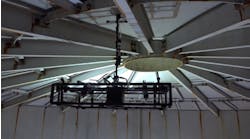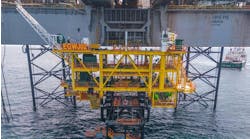William Furlow
Houston
Tool allows continuous bit course correction
Baker Hughes Inteq has an improved directional drilling system that contains its own programmed controller and steering sub, and drills continuously in the rotary mode. Steering of the product is controlled by a non-rotating, orienting sleeve trough expanding stabilizer pads.By regulating the force on these pads an operator can maintain the inclination alignment and direction within the programmed well path. Because the course corrections are made continuously while drilling there are no trips required for tool adjustment. Surface monitoring is done in real-time so wellpath corrections can be made. The system features measurement while drilling and geosteering rotary drilling capabilities.
Gary Rich of Baker Hughes Inteq drilling and evaluation technology center said several of the tools are already at work in the field. He claims they are able to boost the rate of penetration (ROP) 20-30% by eliminating the need for slide drilling. AutoTrak provides for the selection of a more aggressive bit without the risk of differential pressures on the bit generated during slide drilling.
Lubricity tester goes horizontal
Newpark Drilling Fluids has unveiled a new Lubricity evaluation device to test drilling fluid performance in a simulated horizontal wellbore. Norman Kenney, vice-president of technology for Newpark, said horizontal drilling presents a variety of unique challenges for fluid design.To date, test facilities had been vertically oriented, ignoring the horizontal forces at work on these wellbores. Slide drilling, used in stepping out and horizontal drilling, generates more drag than rotary drilling, creating heat and pressure as well as poor fluid and cuttings circulation and inefficient hole cleaning.
Each of these problems requires a specially formulated drilling fluid, but until now these fluids would have to be tested in the field or using a vertical simulator. The new device uses a stainless steel rod run through an actual core sample inside a core holder that is subjected to the pressure and drag present on an actual horizontal drill string.
The pressure and drag are generated by hydraulic actuators, and the mud being tested is circulated through the core holder as it would be in the borehole. The simulator then reports the pressure of the drillstring on the face of the formation. Kenney said the device has measured pressures up to 783 psi and temperatures up to 180° F. The device is currently testing fluids on core samples from the Austin Chalk, where horizontal wells are prolific, but Kenney said the offshore applications are broad.
Wytch Farm steps out over 10,000 meters
British Petroleum and partners on the Wytch Farm Field in Dorset, UK on the shores of Poole Bay. The new stepout of 10,114 meters beat the previous record by 2,051 meters. The M11 well took 173 days to drill and case. It reached a TD of 10,658 meters, with a true vertical depth of 1,605 meters.At 1,200 meters, 13-3/8 in. casing was set in M11 at the full target angle of 83°. More than 700 meters of 12-in. hole was then drilled to the next casing point. At 7,500 meters measured depth (MD), 6,000 meters of hole had to be abandoned when formation instability prevented a return to the drilling section after a trip to change the bit.
After minor adjustments to the directional drilling program and the mud, this section was successfully drilled to 8,890 meters. This section reached the top of the reservoir, 1,600 meters vertical depth. At this point 9-5/8-in casing was run.
According to Deutag Drilling, the drilling contractor on this project, friction on the long tangent section of this well would have quickly overcome the weight of the casing if it had been run using conventional methods. Deutag avoided filling the casing string with mud and used its natural buoyancy to float it downhole.
On this well, only the first 1,000 meters of casing was filled with mud. above a special floater valve that allowed the last few meters of casing to reach the bottom of the borehole. The weight of the top drive unit was used to push the casing into the hole. Near the bottom, the top drive was directly connected to the casing to turn the whole string. Only 15,000 ft-lb were required to turn the string and take it down to 8,888 meters.
The M11 is the 14th extended reach well drilled since BP began the Wytch Farm project in 1993. This well is part of Stage 3 development of the offshore section of the field's Sherwood reservoir. Wytch Farm produces 100,000 b/d from the Sherwood Triassic and Bridport Jurassic sandstone. Half of the field's recoverable reserves lie offshore under Poole Bay. Original plans were to drill this well offshore on an artificial island, but this extended reach project was shown to be more cost effective.
Water temperature fluctuations in US Gulf
Loop current eddies, runoff from the West Delta of the Mississippi River, or rogue currents from the ultra-deepwater Gulf of Mexico - which is it? These are questions Agip Petroleum is asking after monitoring temperature fluctuations off two production platforms in Grand Isle Block 102 only 50 miles offshore in the Gulf of Mexico.Ed Van Dike, production engineering supervisor for Agip, said he became interested in these anomalies about three years ago when a hydrate plug formed in a production line about 8 miles from one of the platforms. The 16-in. gas sale line was transporting 100 MMt/d of un-dehydrated gas from the A platform in about 250 ft of water. Van Dike said the hydrate temperature at this pressure, 1,100 psi, was 60° F. That may not seem like very cold water, but the blockage occurred in July.
Curious, Van Dike installed thermo-couplings on the two platforms, about a mile apart, and began measuring the near bottom temperature fluctuations. What he found surprised him. There were quite a few spikes, as much as 10° in one day and the biggest fluctuations were during late June and early July, when temperatures would run anywhere from the high 60s to the low 50s. In some cases, there would be a temperature drop at one platform and none at the other, just a mile away.
Van Dike said he has not measured current speed or direction at these depths, nor has he taken salinity or oxygen readings, but he said he would like to see a study designed to predict these rapid fluctuations. If nothing else, it would save on the cost of methanol which is fogged into the line to avoid hydrate formation. Van Dike said he is currently querying DeepStar to gauge their interest in sponsoring such a study.
Copyright 1998 Oil & Gas Journal. All Rights Reserved.


